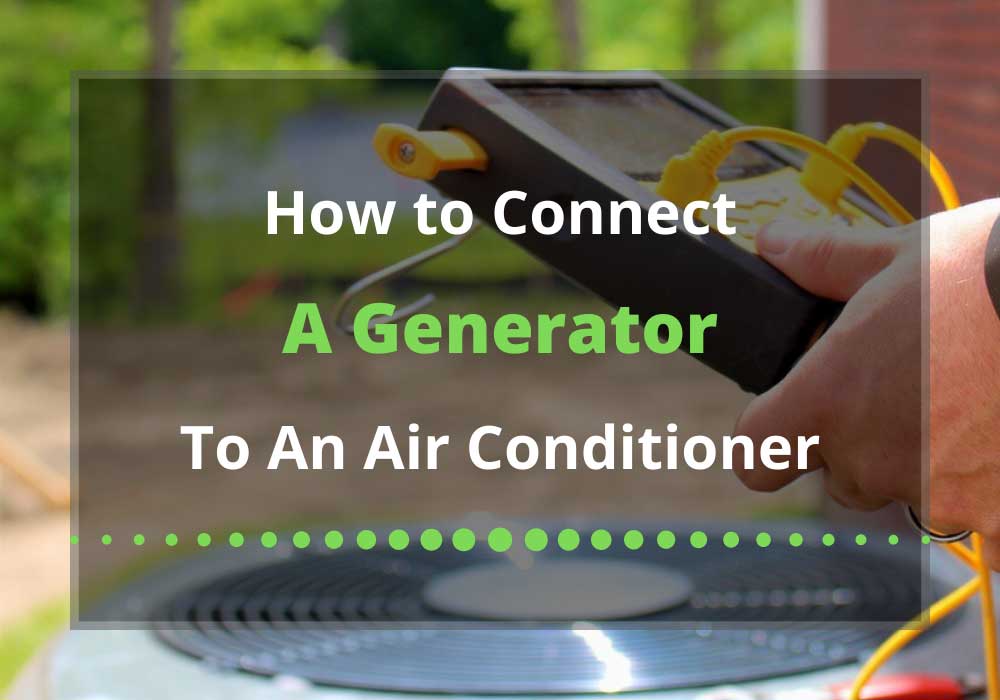Homeowners who lose their main power source can benefit from a portable generator, which provides emergency power. A generator can be used to power any window air conditioner.
There may be certain appliances that you cannot power with a generator of the size you have. Therefore, generator capacity is determined primarily by the amount of power they can handle.
The wattage and size of different air conditioning units vary a lot, just like there is no universal generator. How many window units will you be powering, or are you planning to run a 3-ton furnace? Different ACs require different amounts of power.
Contents
How to Connect Generator to Air Conditioner
- Step 1: Install Transfer switches between your furnace and circuit breakers
- Step 2: Turn off the circuit breakers
- Step 3: Cut off the wire and install a breaker panel outlet
- Step 4: Connect the furnace
- Step 5: Place the generator in safe zone

Can You Run An Air Conditioner On A Generator?
Make sure that you do your research before purchasing a standby home generator for use with your air conditioner. It’s worth noting that generators come in a lot of shapes and sizes, and you shouldn’t use your generator to power your AC if it can’t handle the load.
Read more: Can A Portable Generator Run an Air Conditioner
Generators can be used in most situations. A portable gas-powered generator is the smallest generator available. An industrial-size generator can provide power for an entire facility.
Two types of generators homeowners are likely to have: small, portable ones and whole-house generators. Generators are generally installed by electricians, who connect them to one of the two panels, depending on the size and specifications of the generator.
By connecting your generator to a panel, you can more efficiently and safely distribute power throughout your house.
What Size Generator Do I Need To Run My Air Conditioner?
Generator capacity is determined primarily by the amount of power they can handle. In order to determine whether the generator you choose is sufficient to power a window AC, you need to do some basic math and planning.
Window air conditioners are rated in two wattages: starting and running during startup, when the motor starts turning, starting resistance and inertia force the motor to draw a higher current. This is why starting wattage is higher.
Typical window units have a starting power of 2200 watts. In a steady-state, the motor’s amperage decreases, and its wattage is typically about 1500. It is possible that your unit has a different rating. You can find out how much power your AC unit uses by checking the nameplate or specifications in the manual.
A generator’s wattage rating determines how efficient it is. In an emergency, a homeowner might use a portable generator rated at 4,000-7,000 watts. Standby power models for the whole house usually have a capacity of 25,000 watts or more.
You can’t just add up the watts of the appliances you will use to decide what size generator to buy if you’re considering buying one. The optimal use of your generator can be achieved with clever power management strategies.
Connect A Generator To An Air Conditioner Step by Step
There is usually more than one outlet on portable generators, so you can plug extension cables into them to power devices around the house.
Despite its limitations, this method is effective. Also, multiple extension cords might be a tripping hazard and are not convenient to grapple with when the doors or windows are open.
Step 1
Furnace circuits are usually directly connected to homes’ furnaces. Transfer switches should be installed between your furnace and circuit breakers in order to connect the generator.
Professional electricians should install this device. Before starting the process, you should contact an electrician if a transfer switch hasn’t already been installed.
Step 2
Turn off the furnace’s circuit breaker before you do anything else. Make sure that you do not electrocute yourself by leaving the power on.
Step 3
Cut the circuit breaker wire that runs from the furnace. Next, install a breaker panel outlet. To use the generator when necessary, make sure the generator is plugged into the extra outlet by the circuit breaker.
Step 4
Connect the plug to the furnace’s side. Reboot the breaker after plugging in the furnace. Your furnace should still work, and you should check your generator, as well.
Step 5
The generator should be placed somewhere safe. Due to its ability to emit carbon monoxide, you should keep it in a garage or out of your home.
Keeping it out of reach of children and water is also a good idea. In the event of an outage, connect your furnace to the generator with an outdoor extension cord. Be careful not to overload it. Otherwise, your home will not be able to be heated/cooled.
Final Words
A portable generator will power your AC unit, but you’ll probably need one with a higher wattage. It’s not enough to run most central air conditioners with a little, quiet generator of 2,000 watts. Whether you’re tailgating or camping, portable generators are perfect for running small appliances and tools. And that’s all there is to it. If you don’t feel like doing it by yourself, consider hiring an electrician to connect a generator to an air conditioner.